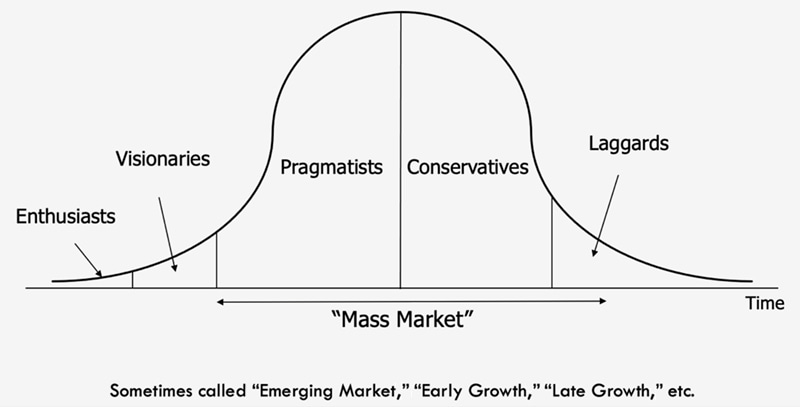An appealing marketing strategy for a company is to launch a brand-new product into the market. Such a product defines a new category or it's a totally new application of some prior product.
To help us think strategically about the benefits and risks of launching a brand-new product to the market, it's useful to frame the process as a life cycle.
The life cycle has stages: Enthusiasts, Visionaries, Pragmatists, Conservatives, and Laggards. Those stages have been identified in Everett Rogers' Diffusion of Innovations Theory (1962) and Geoffrey Moore's Crossing the Chasm (1991).
Let's investigate each of the main stages, especially from a customer-centric point of view—i.e., the types of customers a company will attract at each stage.
Here is a simple picture of the process to get us started:

Enthusiasts
In the introduction stage, when a new product is first introduced to the market, the goal is to create awareness of the product and generate interest in it.
The product is usually priced high during this stage, and the company invests heavily in marketing and advertising.
The first challenge in this stage is that you need to educate the market (because potential customers might be asking "what is this?"). That often requires resources (money and time), since most companies don't have a lot of experience with pure education.
The other main challenge is that the first mover doesn't know the best positioning for the market. Moreover, competitors often wait, which gives them two advantages:
- They don't need to spend money educating the market.
- They can wait to see the best positioning.
What's happening with customers? Often, much of the market stays with the status quo (i.e., does nothing) even when the benefits of switching or making a change are high.
Customers have many reasons to stay with the status quo, including the following:
- Regret minimization: Staying with the status quo means you won't have many regrets. There is also a loss-version bias, which reinforces the do-nothing approach.
- Consistency bias: People like to stay with what they have.
- Habits: People gain pleasure from the familiar.
- Psychological switching costs: This is a big one... Companies often find ways to deal with technological switching costs, but psychological costs are typically underestimated.
You can use various product and message techniques to help adoption during this phase, including providing free trials, making the product/service very easy to use, making the benefits very easy to observe, and solving the psychological switching costs problem.
Visionaries
The early growth stage is when the product starts to gain popularity and sales start to increase. The company continues to invest in marketing and advertising, but prices start to come down—often due to the entrance of competitors.
The goal of this stage is to maximize sales and profits.
Visionaries can see the reasons to adopt a new product idea or technology:
- They can identify enhancements of capability.
- They find ways your product increases productivity.
- They find ways your product reduces the total operating costs.
Pragmatists
The pragmatist stage is when the product begins to approach its peak in popularity and sales eventually plateau. The company still invests in marketing and advertising, but prices are now at their lowest.
The goal of this stage is to maintain market share and profits.
Pragmatists is a good name for the types of customers you see during this stage. They are pragmatic, they must be shown a reason to adopt a new technology. You must demonstrate or otherwise show...
- Enhancement of strategic capability
- Radical new productivity
- Visible, verifiable, and significant reduction in total operating costs
Pragmatists typically want "whole solutions": ready availability, support, documentation, etc.
Compatibility with internal processes is important to them. Again, companies often underestimate this issue because they are focusing on the product itself, but the pragmatists must deal with internal processes.
Conservatives & Laggards
Conservatives and Laggards tend to be highly risk-averse. Conservatives have even more preference for whole solutions, ease of use, and low prices than pragmatists. And they have even more fears, uncertainties, and doubts (FUD).
Laggards, meanwhile, focus mostly on simplicity and ease of use. They tend to be intimidated by new technology and may feel overwhelmed by complexity. By highlighting how easy and straightforward the product is to use, you can make it less intimidating and more appealing.
Also, Laggards may be more likely to adopt a new product if they see that other people like them have already tried it and found it valuable. Use customer testimonials to demonstrate the benefits of the product and encourage Laggards to give it a chance.
* * *
The product life cycle is a useful tool for marketers to understand the different stages of their products' lives.
By understanding those stages, marketers can make better decisions about when to sell new-to-the-world products, and when to replace products.




